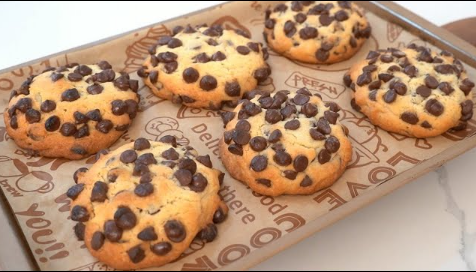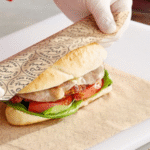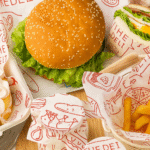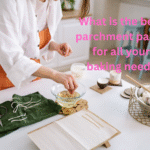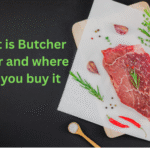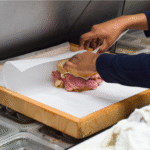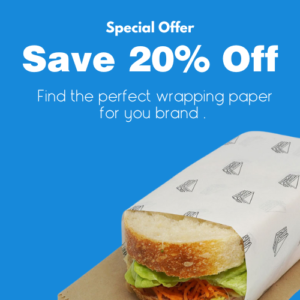What is Parchment Paper?
Parchment paper is a non-stick, heat-resistant paper often used in baking and cooking. It is typically coated with silicone, which gives it its non-stick properties, making it perfect for use in a variety of culinary applications. Parchment paper can withstand high temperatures, usually up to around 420°F (215°C), which makes it ideal for oven use.
The silicone coating also makes parchment paper moisture-resistant, allowing it to be used for tasks that involve liquids, such as steaming or poaching food. Parchment paper comes in various sizes, pre-cut sheets, and rolls, making it convenient for different kitchen tasks.

Key Benefits of Parchment Paper
Parchment paper has several key advantages that make it an invaluable tool in the kitchen:
Non-stick Surface: The primary benefit of using parchment paper is its non-stick surface, which ensures that food doesn’t stick to pans or baking sheets. This is particularly useful for baking cookies, cakes, and pastries.
Easy Cleanup: Parchment paper significantly reduces the need for greasing baking pans and sheets. Because it prevents sticking, cleanup becomes much easier — no more scrubbing burnt or stuck-on food from cookware.
Even Baking: Parchment paper helps distribute heat evenly across the baking surface, which leads to better, more consistent results in baked goods like cookies, cakes, and pastries.
Heat Resistant: Since parchment paper can withstand high temperatures, it is safe to use in ovens for baking, roasting, and even broiling.
Versatility: Parchment paper isn’t limited to baking. It can be used for a variety of tasks, including steaming, roasting, and lining food pans. It’s also helpful in non-cooking tasks like rolling out dough.
The Different Uses of Parchment Paper
Parchment paper is highly versatile and can be used in a range of culinary applications. From baking to steaming, the following sections explore the many ways you can use parchment paper in your kitchen.
Baking
Perhaps the most common use for parchment paper is in baking. Lining baking sheets with parchment paper prevents baked goods, such as cookies and pastries, from sticking to the surface. It is also frequently used to line cake pans, which allows for easy removal of cakes after they are baked. Parchment paper is particularly useful for delicate bakes like meringues, macarons, and sponge cakes, where sticking can ruin the presentation.
Another great advantage is that parchment paper promotes even baking. Because it helps distribute heat more uniformly across the surface of baked goods, you are less likely to encounter unevenly cooked treats.
Roasting
In addition to baking, parchment paper is an excellent tool for roasting vegetables, meats, and fish. When you line your baking tray or roasting pan with parchment paper, it prevents food from sticking to the pan and makes for easy cleanup. This is especially useful when roasting items like chicken, potatoes, or squash that can leave behind sticky or greasy residues.
Parchment paper also allows for healthier cooking because you can roast without using oils or fats, which are often used to prevent sticking.
Wax Paper:
Coating: Wax paper is coated with a thin layer of paraffin wax, which makes it non-stick but not heat-resistant.
Uses: Wax paper is best used for tasks like wrapping food, rolling out dough, or separating layers of food. However, it should not be used in the oven as the wax coating can melt and even catch fire at high temperatures.
Heat Resistance: Wax paper is not heat-resistant and should never be used in the oven.
Choosing the Right Parchment Paper for Your Needs
There are different types of parchment paper available, and choosing the right one depends on your specific needs in the kitchen. Here are some factors to consider when selecting parchment paper:
Bleached vs. Unbleached
Bleached Parchment Paper: This type of parchment paper has been treated with chemicals to achieve a white color. It is widely available and safe for most kitchen uses.
Unbleached Parchment Paper: Unbleached parchment paper is brown and has not undergone the chemical bleaching process. It is often considered a more eco-friendly option.
Pre-Cut Sheets vs. Rolls
Parchment paper is available in both pre-cut sheets and rolls. Pre-cut sheets are convenient and ready to use, while rolls allow you to cut the paper to your desired size. Pre-cut sheets are ideal for specific tasks like lining baking trays, while rolls provide more flexibility for different tasks.

How to Maximize the Use of Parchment Paper in Your Kitchen
Parchment paper is one of those versatile kitchen tools that can be used in many different ways. Here are some tips to help you maximize its utility in the kitchen:
Cut to Fit Your Bakeware: When lining a cake pan, trace the bottom of the pan on the parchment paper and cut it to fit perfectly. This ensures that your cakes will come out easily without sticking to the bottom.
Create Parchment Paper Slings: For brownies or bars, line your baking pan with parchment paper, leaving extra paper hanging over the sides. This creates a “sling” that makes it easier to lift the baked goods out of the pan once they are done.
Your destination for sustainable Food Packaging Wax paper, butcher paper, Gift/Food wrapping paper ,parchment Paper and paper bags provided by The Deli Paper.
Reuse When Possible: Parchment paper can be reused for multiple batches of cookies or baked goods. As long as it isn’t too greasy or torn, you can use the same sheet of parchment paper for subsequent baking.

